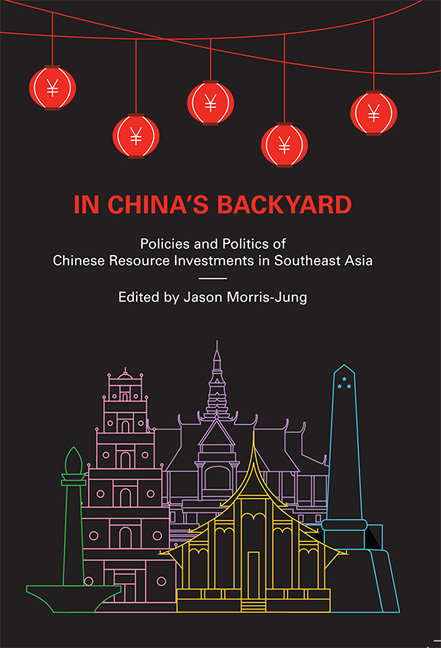Book contents
- Frontmatter
- Contents
- Foreword
- Acknowledgements
- About the Contributors
- 1 Introduction
- 2 Mixed Motivations, Mixed Blessings: Strategies and Motivations for Chinese Energy and Mineral Investments in Southeast Asia
- 3 Mineral Resources in China's “Periphery” Diplomacy
- 4 Energy Entanglement: New Directions for the China–Indonesia Coal Relationship
- 5 Indonesia–China Energy and Mineral Ties: The Rise and Fall of Resource Nationalism?
- 6 The Direction, Patterns, and Practices of Chinese Investments in Philippine Mining
- 7 Development Cooperation with Chinese Characteristics: Opium Replacement and Chinese Rubber Investments in Northern Laos
- 8 The High Cost of Effective Sovereignty: Chinese Resource Access in Cambodia
- 9 Complex Contestation of Chinese Energy and Resource Investments in Myanmar
- 10 Anti-Chinese Protest in Vietnam: Complex Conjunctures of Resource Governance, Geopolitics and State–Society Deadlock
- 11 Complexities of Chinese Involvement in Mining in the Philippines
- 12 Conclusion
- Bibliography
- Index
6 - The Direction, Patterns, and Practices of Chinese Investments in Philippine Mining
Published online by Cambridge University Press: 04 July 2018
- Frontmatter
- Contents
- Foreword
- Acknowledgements
- About the Contributors
- 1 Introduction
- 2 Mixed Motivations, Mixed Blessings: Strategies and Motivations for Chinese Energy and Mineral Investments in Southeast Asia
- 3 Mineral Resources in China's “Periphery” Diplomacy
- 4 Energy Entanglement: New Directions for the China–Indonesia Coal Relationship
- 5 Indonesia–China Energy and Mineral Ties: The Rise and Fall of Resource Nationalism?
- 6 The Direction, Patterns, and Practices of Chinese Investments in Philippine Mining
- 7 Development Cooperation with Chinese Characteristics: Opium Replacement and Chinese Rubber Investments in Northern Laos
- 8 The High Cost of Effective Sovereignty: Chinese Resource Access in Cambodia
- 9 Complex Contestation of Chinese Energy and Resource Investments in Myanmar
- 10 Anti-Chinese Protest in Vietnam: Complex Conjunctures of Resource Governance, Geopolitics and State–Society Deadlock
- 11 Complexities of Chinese Involvement in Mining in the Philippines
- 12 Conclusion
- Bibliography
- Index
Summary
The literature on Chinese overseas foreign direct investment (FDI) in theGlobal South has generally pursued a global approach or state-to-stateanalysis. However, these overlook changes at the local level as Chinese FDI hasrekindled the emergence of historical tensions among groups, local strugglesfor control, and anxieties toward globalization in the twenty-first century. Thus,this gap presents an opportunity to analyse China's engagements at multiplelevels with a variety of regional actors across different scales, places, andcontexts. This chapter shows how the patterns and practices of Chineseinvestments in Philippine mining differ from conventional multinationalmining investments. First is the method of production. Multinational miningcompanies focus on large-scale mining (LSM), but Chinese investments tendto gravitate towards artisanal small-scale mining (ASM) to evade scrutinyfrom national authorities and hostile reactions associated with currentterritorial disputes between the two countries. Second is the method ofaccumulation. While multinationals use capital-intensive, ASM capitalizeson labour-intensive extraction, community-centred and house-driven support.And last are the host country linkages. While multinational mining companiesneed the support of national government agencies to pursue resourceextraction, Chinese mining relies more on connections with overseas Chinesecommunities in the Philippines to access subnational political elites, such asregional politicians, governors, and local officials.
Introduction
This chapter shows how the patterns and practices of Chinese investments in Philippine mining differ from conventional multinational mining investments. While Ching Kwan Lee has previously argued that there are different practices between Chinese and multinational mining companies in Zambia, the author suggests that Chinese investment in the Philippine mining sector presents an analogous case. First is the method of production. Multinational mining companies focus on large-scale mining (LSM), but Chinese investments tend to gravitate towards artisanal small-scale mining (ASM) to evade scrutiny from national authorities and hostile reactions associated with current territorial disputes between the two countries. Second is the method of accumulation. While multinationals use capital-intensive infrastructure and formalized ways of pursuing extraction, ASM capitalizes on multiple methods and ways: labour-intensive extraction, communitycentred and house-driven support, and flexible infrastructure. And last are the host country linkages. While multinational mining companies need the support of national government agencies to pursue resource extraction, Chinese mining relies more on connections with overseas Chinese communities in the Philippines to access subnational political elites, such as regional politicians, governors, and local officials.
- Type
- Chapter
- Information
- In China's BackyardPolicies and Politics of Chinese Resource Investments in Southeast Asia, pp. 129 - 153Publisher: ISEAS–Yusof Ishak InstitutePrint publication year: 2017

